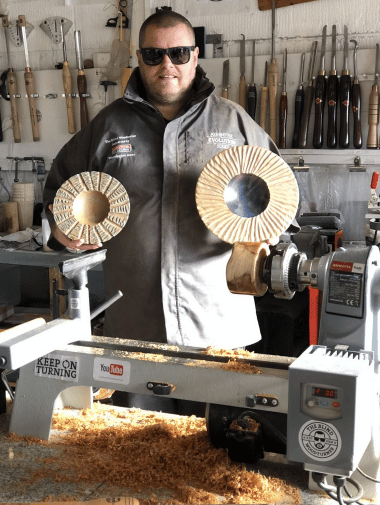When most people think of woodturning, they envision someone carefully working a piece of wood on a lathe, using precise tools to create a beautiful and functional work of art. But for one blind woodturner, the process is entirely different. This extraordinary craftsman relies on touch and smell to create his stunningly intricate creations.
The former engineer was just 39 years old when a parasite ailment called toxoplasmosis caused him to lose his vision over the course of four weeks gradually.
Though he has never been able to see his work, the blind woodturner has developed an incredible sense of touch that allows him to manipulate the wood in just the right way. His hands glide over the surface, sensing any irregularities that need to be corrected. He can tell which way the grain runs and how hard or soft the wood is. As he shapes the wood, he uses tools that he has memorized through years of practice.
In addition to his extraordinary sense of touch, the blind woodturner also has a keen sense of smell. He can identify different types of wood by their scent and uses this ability to choose the perfect piece for each project. By combining his two senses, he is able to create truly unique and one-of-a-kind works of art.

Chris now imparts knowledge to young people with impairments and is a YouTube phenomenon, where he shares his breathtaking works with thousands of fans.
The married father of one claims that despite working with hazardous equipment and razor-sharp blades, the images develop in his head as he uses his sense of direction to navigate.
Additionally, because of how delicate his fingers are, he is able to tell by touch whether the wood has been painted with precise detail.
Chris, of Hulland Ward, Derbys., UK, said he first tried woodturning because he wanted to make a vampire stake as a Halloween prop.

He said, “It all started, strangely enough, because I wanted a stake as I’m a big horror film buff. But I didn’t just want to get a piece of wood out of the garden and just whittle a stick or a twig, I wanted something more stylized. After getting the lathe and starting it was probably about a month of trials, tribulations and errors and mistakes until I had a vampire stake that I was happy enough to display as a prop. That was just the start and it evolved into all the other things that woodturners are synonymous with – goblets, platters, bowls, handmade pens, candlesticks. I start shaping pictures in my mind and then I will stop and have a feel. It’s obviously quite a stop-start but I learned to persist. Everything is considered action. I’m also listening to all the time for auditory cues. There are good and bad sounds and I’m listening to make sure a piece is balanced, safe, and running smoothly. I can tell by the interaction between the tool and the wood if there is a flaw in the wood or a crack. My sense of smell helps me with wood recognition. I can tell whether something is sycamore or oak using my nose. Some woods have a hot butter popcorn-like smell, while African woods tend to be more medicinal. I still have a sense of what the world looks like in my mind’s eye as I could see for nearly 39 years so I still rely on that. To work with dangerous machinery you have to make sure everything is perfectly in the right place and never deviate away from that. But it’s quite spontaneous, instinctive, and free-flowing and hopefully, I eventually end up with something that feels pretty cool. My goal is to inspire others by demonstrating that anything is possible and to show the world that having a disability isn’t the end, it’s just a new beginning.”

Chris hopes to reach other visually impaired woodturners to go pro with their hobby.
“Hopefully that’s opened the gates for other visually impaired woodturners that might want to go for their professional accreditation. I’ve done it, so there’s certainly nothing stopping them. At the minute I’m the one and only but hopefully there will be more in the future.”
Watch this video to hear exactly how Chris Fisher does it:













